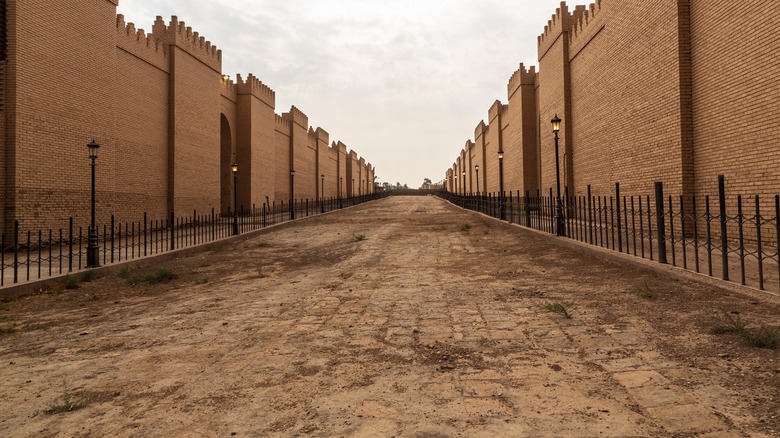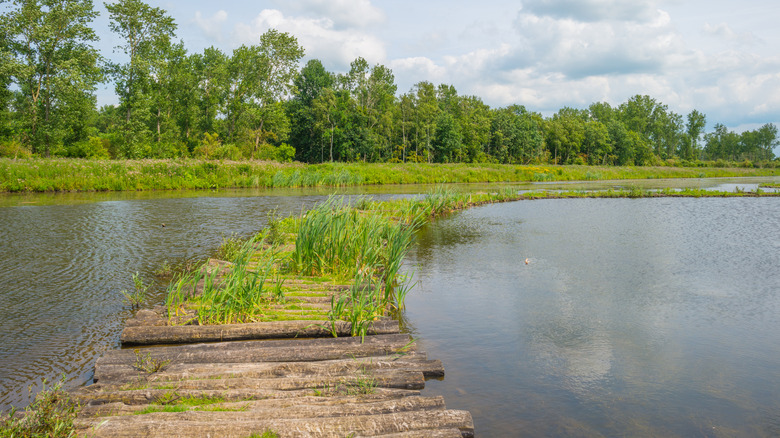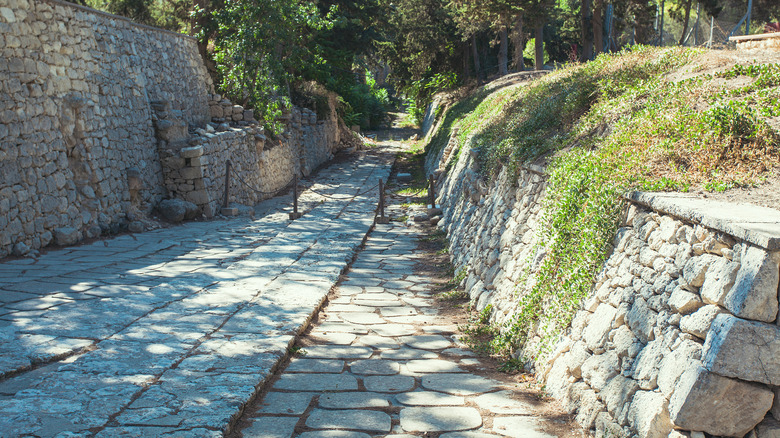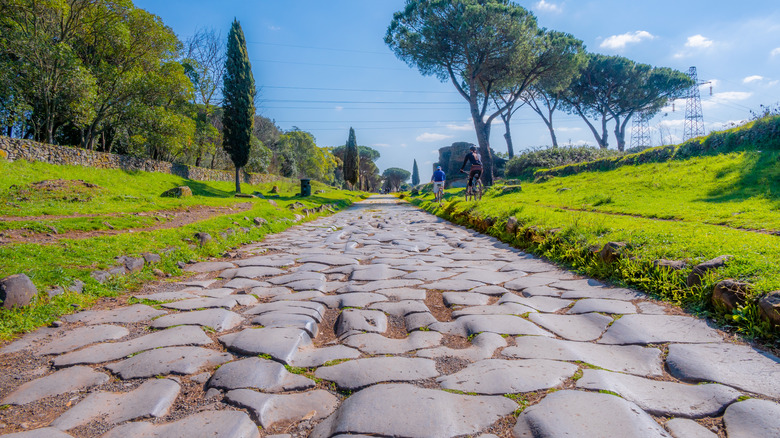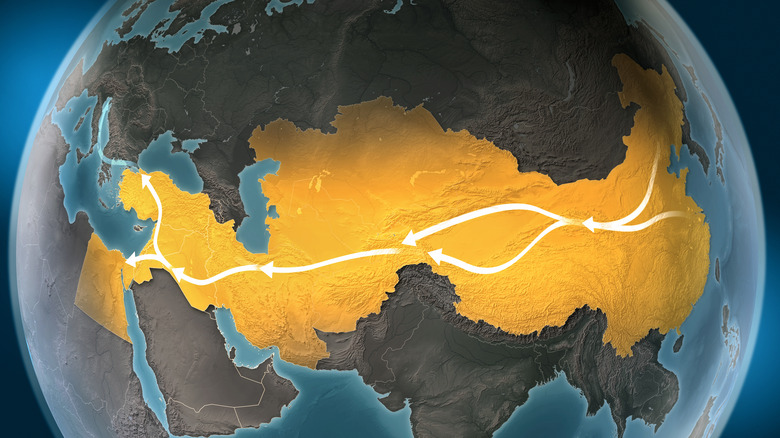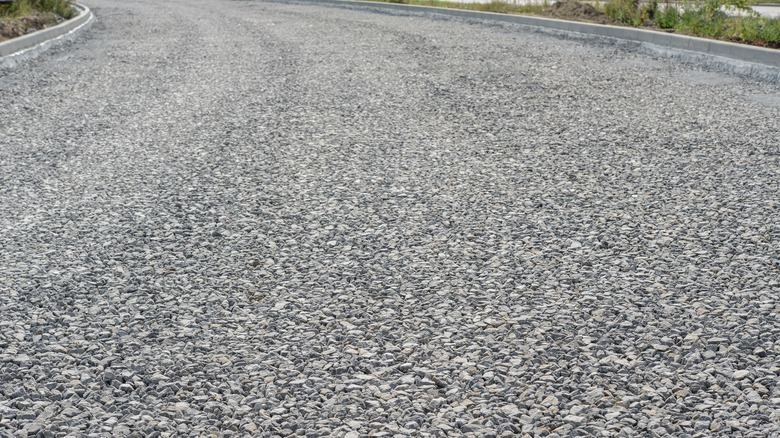The Long And Winding History Of Roads And Highways From Mesopotamia To Modern Day
The last thing most people think about when they hop in the car to run an errand, commute to work, or head out on a grand tour road trip journey is the actual road they're traveling on. Streets and freeways are taken as much for granted, perhaps, as the air we breathe. But they are the ubiquitous arteries that take our modern, mechanically horse-powered carriages from point A to point B, move freight from shore to shore, and bring packages to our front door. Where would we be without them?
According to the Department of Transportation, drivers in the United States set a new record in 2023 by driving 3.26 trillion miles. Globally, the total road network is estimated at somewhere around 40 million miles, which some have claimed is "the largest human artifact on earth." Stats from the Federal Highway Administration say the United States had more than 4.2 million miles of thoroughfares crisscrossing the continent in 2022, making it the single most extensive network of roadways on the planet. Today, the Netherlands even has highway lanes that glow in the dark.
Let's take a road trip of our own to see exactly how the first streets in ancient Mesopotamia came into existence and how the original roads we made to get around evolved into the clogged eight-lane superhighways of today.
Sumerians paved the way in Mesopotamia
So, how did roads even become a thing? Well, humans started using what nature supplied them with: game trails used by animals. These paths through dense undergrowth and forests were well-worn and easy to navigate, thanks to animals clearing the way. The first uses of these paths dates back 8,000 years ago to a region outside the ancient city of Jericho on the West Bank of the Jordan River in the State of Palestine.
The first handmade roads appeared about 6,000 years ago in Ur and Babylon. These two primeval cities were part of Mesopotamia (now Iraq) and home to the Sumerians, who are thought to have been some of the first people to make things like the wheel, the chariot, writing, metallurgy, arithmetic, and irrigation. They devised a way to mass-produce clay bricks (another first for these Mesopotamian masterminds) to make homes, temples, cities, and roads. Once the bricks dried, they'd set them into place using bitumen, which can be made by burning coal. The resulting leftovers form a sticky black substance often referred to as pitch, which can then be used as an adhesive. Funnily enough, bitumen is a form of asphalt that wouldn't be "invented" for thousands of years.
The rest of the world made its own winding paths
While the Sumerians were doing their thing, several other groups in disparate parts of the world began constructing "roads" differently. People in Glastonbury, England created wooden paths surrounded by marshlands, for example. One such road was named Abbot's Way when it was discovered in 1873 because it was initially thought to have been built under the rule of Abbot of Glastonbury sometime during the Middle Ages. However, it was later revealed that the path was built about 4,500 years ago, meaning it was constructed long before Abbot was ever in the picture.
Meanwhile, the Persian Royal Road, which stretched 1,500 miles from the Persian Gulf to the Mediterranean Sea, was being constructed to increase the capacity for trading. It is thought to be the "earliest long-distance road," and historians believe it was used as far back as 3500 BCE. While under the control of the Achaemenian Empire (around 475 BCE), it was extended to nearly 1,800 miles from northwest Turkey to Iran. This time, the road was outfitted with stations that were home to rested horses so messengers could accomplish their tasks faster.
The Egyptians used stones to make roads
In 1994, U.S. Geological Survey geologists Dr. James A. Harrell and Dr. Thomas Bown discovered the Lake Moeris quarry road in Egypt. Based on pottery fragments, they estimate it was used from approximately 2600 to 2200 BCE to transport massive dark volcanic basalt blocks from a quarry 43 miles southwest of Cairo. The basalt was used to build royal sarcophagi and line the insides of mortuary temples at Giza.
The "road" was made from sandstone and limestone slabs and ran several miles at an average width of 6.5 feet. The scientist who uncovered the road also found some petrified logs, which they believed were used like wheels to move the big basalt blocks more easily. The idea is that the sandstone and limestone slabs worked like sleds, holding up the incredible weight of the basalt blocks as they rolled along and kept everything from sinking into the sand. Some sources also call the Lake Moeris quarry road the world's oldest paved road.
The Greek Historian Herodotus noted that the Egyptians were also constructing roads around this time to transport building materials for pyramids. Archaeologists also found some paved roads leading to sacred temples.
Early byways crisscrossed the land
Jumping ahead to 2000 BCE, the Minoans built a 30-mile-long thoroughfare on the island of Crete in the Mediterranean Sea, not far from where the mysterious Antikythera mechanism (thought to be the world's first computer) was found. The Crete road stretched from the island's south coast up and over a mountain (with an elevation of 4,300 feet) to its north coast. This 12-foot-wide way was built using layers of sandstone held together with clay-gypsum mortar. A crowned center supported by two rows of 2-inch thick basalt slabs allowed the water to drain correctly. Some spots even had gutters. Historians believe pedestrians used the center strip while carts and animals were pushed to the outside lanes.
Around this time, ancient paths known as the Amber Routes also began to appear in Europe. Some portions of the Amber Routes were preserved in wetlands, anchored to the ground with pegs that struck through a few layers of criss-crossed branches and logs. Four ended up being built across the centuries and used to move goods, including lead, tin, salt, flint, and, of course, amber. These were maintained and, over time, became linked to form a rudimentary network.
The Romans made history with their road design
The Romans are the unquestionable road-building G.O.A.T.s (greatest of all time) of the Old World. Good infrastructure was paramount to moving their mighty legions efficiently, so they began building a network of ways in 334 BCE that spanned some 53,000 miles.
The Roman method quickly became regarded as the way to build roads for centuries. They typically used a straight line-of-sight method, knocking down everything in their path. After digging a pair of drainage trenches 40 feet apart, they reused the flattened material to build and elevate a base foundation 3 feet high. A Roman road could be anywhere from 3 to 6 feet deep. Appian Way, one road often used by the military, was 35 feet at its widest point and had designated lanes for chariots and foot traffic.
It's worth noting that the Romans likely borrowed knowledge from previous societies to perfect their methods, including cement and street paving technology from the Etruscans, masonry from the Greeks, surveying from the Egyptians, and other skills from the Cretans, Carthaginians, and Phoenicians.
Roads began connecting distant civilizations
Ancient roads also sprouted up in South and East Asia, including China's Imperial Highway and The Silk Road (the ancient trade route, not the illegal marketplace on the dark web subject to a record-breaking $3.36 billion Crypto seizure). Today, the latter is actually sometimes known as The Silk Routes because it wasn't just a single path. This network ran roughly 4,000 miles and connected Europe to East Asia. It was at one time the longest "road" on Earth, not only helping bring goods like silk, jade, porcelain, tea, and gunpowder into Europe but also new religions, ideas, and technologies that changed human history.
In Europe, as the mighty empires of old faded away during the Middle Ages, their previous system of roads deteriorated. It remained that way until Charlemagne, who reigned as Holy Roman Emperor in the late 8th century, made an effort to restore the Roman Empire to its former glory. In the 12th century, paving streets in European cities became all the rage, and by the 15th, wheeled vehicles had increased so much that bringing goods into cities required roads to be maintained appropriately.
Around the same time, the Incans in South America constructed 14,000 miles of road, which, according to 16th-century explorers, were better than those in Europe. One hugged the coastline for 2,250 miles, while another followed the Andes Mountains for 3,400 miles with retaining walls, suspension bridges, and terraced steps cut into the rocks.
Roads became modernized as carriages gained popularity
This finally brings us to the modern era of road making. With an increasing number of people traveling about in more advanced wheeled "vehicles" (the animal-drawn kind), it was time to take a more serious approach to rectifying the decaying road system left behind by the Romans.
Guido Toglietta, an Italian engineer, got the wheel rolling (pun intended) in 1585 when he wrote a paper on how to build roads using smashed up stones, which was one of the first major improvement in the process since the Romans. In 1607, Thomas Procter published a seminal book on roads, and in 1747, the first school specifically aimed at teaching students highway engineering opened in Paris.
Between 1752 and 1791, John Metcalfe started building roads and bridges in and around Yorkshire, England. The Scotsman used three layers of stones of varying sizes which combined for proper drainage, a key component to making long-lasting roads. In 1775, Frenchman Pierre-Marie-Jérôme Trésaguet created a new kind of road surface that was lighter than previous attempts. Basically, his technique used the actual ground on which the road was built to support its weight, instead of relying so much on the stones placed on top to do the work. His streets were 18 feet wide and made of three layers of different-sized stones, similar to Metcalf's design. The problem with Trésaguet's design was that a trench needed to be dug so the road would stay level with the surrounding surface, making proper drainage an issue.
Scottish-born engineers raised the bar ... and the road
Two other Scottish-born engineers, Thomas Telford and John Loudon McAdam, improved upon Metcalfe's idea. Telford's name might not be one you remember, but McAdam's probably is because it's still used to describe "Macadam" roads. Telford's design was similar to Trésaguet's but his design differed in that it centered around building a level road above the surface of the existing ground with a stone surface strong enough to withstand great weights.
McAdam began building roads in the early 1800s, incorporating broken loose aggregate instead of shaped stone blocks because it could bear the brunt of even more weight. The shallow cambered crown in the middle, combined with parallel ditches on each side, helped funnel off drainage, which was a major focal point for his designs. Over time, the loose aggregate became packed down, creating a more rigid and stable surface that provided a smoother ride. More importantly, it didn't deteriorate like others. As a result, his model became the de facto road design (known as "macadam") still used today. Many consider McAdam "The Father of the Modern Road" and his idea is considered the most significant road-building improvement since the Romans.
Ford and Benz entered the roadways
Things moved pretty quickly in terms of road development in the 19th century. In 1824, Belgian chemist Edmund de Smedt mixed bitumen with sand and rock to create asphalt. The Champs-Élysées in Paris, considered the first modern road in Europe, was paved with Smedt's concoction the same year. Then, in 1865, concrete was successfully used in Inverness, Scotland when road builders combined cement and stone. The first patch of Smedt's asphalt was put down on a street in Newark, New Jersey, in 1870. The following year, Nathan Abbott filed the first asphalt patent, and the first hot mix production facility in America was opened by the Cummer Company. Today, 94% of all the roads in the U.S. are paved with asphalt.
It wasn't long before the first cars began making their way down these new roads. In the mid-1800s, the first car ever was invented and Carl Benz created the first internal combustion engine-powered car in 1885. In 1902, Welsh inventor Edgar Purnell Hooley combined tar with macadam (crushed aggregate) to create Tarmacadam (aka tarmac). Interestingly, it wasn't the car that drove the paving of the roads but the safety of people on bicycles. However, when Ford began mass-producing the Model T in 1908, the age of automobiles also accelerated the need to improve roads quickly.
Soon after, turnpikes, freeways, and the network of highway systems in the United States (and Europe) were developed. But that's another long and winding tale we'll have to save for another time.

